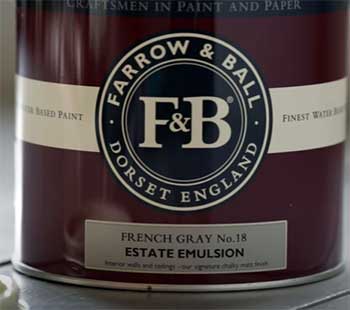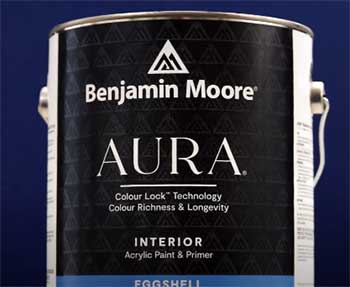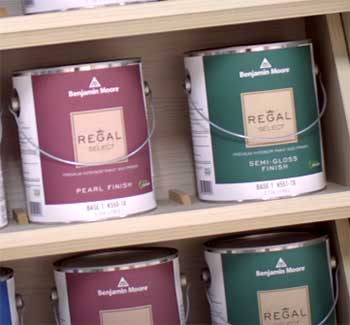I’ve spent years chasing the perfect paint for my home, obsessing over colors that shift with the light and finishes that feel like a warm hug. When it came to choosing between Farrow & Ball and Benjamin Moore, I found myself torn between two giants in the paint world.
This article is my personal exploration of these brands, weighing their pros and cons to help you decide which paint will bring your walls to life. From vibrant pigments to practical application, I’ll share my experiences to guide your next painting project.
A Brief Comparison Table
| Feature | Farrow & Ball | Benjamin Moore |
| Color Palette | Curated 132 shades, rich and nuanced | Over 3,500 colors, vast and versatile |
| Finish Options | Unique finishes like Estate Emulsion, Modern Emulsion | Wide range: flat, eggshell, semi-gloss, high-gloss |
| Price per Gallon | $120–$150 | $50–$100 |
| Coverage | ~570 sq ft/gallon | ~400 sq ft/gallon |
| Durability | Good, but less forgiving in high-traffic areas | Excellent, with durable lines like Aura |
| VOC Content | Low VOC, eco-friendly | Low to zero VOC options |
| Application | Requires primer, trickier for novices | User-friendly, forgiving for DIYers |
| Availability | Limited stockists, online orders | Widely available at local retailers |
| Color Matching | Unique pigments, harder to match | Easily matched at most paint stores |
| Best For | Luxurious, artisanal aesthetic | Versatility, durability, budget-friendly |
My Journey With Paint: Why I’m Comparing These Two?
As someone who’s painted every room in my house at least once, I’ve learned that paint isn’t just about color—it’s about how it feels, how it holds up, and how it transforms a space.
My obsession with Farrow & Ball started when I saw their Pigeon shade in a friend’s bathroom, glowing with a depth I’d never seen before. But then, a trip to my local hardware store introduced me to Benjamin Moore’s Aura line, which promised vibrant colors and durability at a lower price.
I needed to know: which brand was worth my time, money, and elbow grease? So, I rolled up my sleeves and tested both brands in my home, from my sunlit living room to my moody office.
Farrow & Ball: The Artisanal Dream

Farrow & Ball is like the artisanal coffee of the paint world—small-batch, handcrafted, and undeniably luxurious.
Their 132-color palette is curated with intention, each shade named with poetic flair like Sulking Room Pink or Elephant’s Breath.
I painted my dining room with their French Gray, and let me tell you, the way it shifts from green to gray under different lights feels like magic.
The pigments are rich, using natural ingredients like china clay and chalk, which give the paint a depth that synthetic alternatives struggle to match.
Pros of Farrow & Ball
- Unmatched Color Depth: The pigments in Farrow & Ball paints create a luminous, almost three-dimensional effect. In my dining room, French Gray looks alive, changing with the time of day.
- Eco-Friendly Formulas: Their low-VOC, water-based paints are kind to the environment and my indoor air quality. I didn’t get a headache painting my bedroom, which was a relief.
- Luxurious Finishes: From the chalky Estate Emulsion to the durable Modern Eggshell, their finishes feel bespoke. I used Modern Emulsion in my kitchen, and it’s washable without losing its matte charm.
- High Coverage: A gallon covers about 570 square feet, meaning I used less paint than expected for two coats in my living room.
Cons of Farrow & Ball
- Pricey Investment: At $120–$150 per gallon, it’s a splurge. Painting my entire house with Farrow & Ball would’ve cost me a small fortune.
- Tricky Application: Their paints require a specific primer and often two to three coats for rich colors. As a DIYer, I found this process fussy, especially when I forgot the primer and had to redo a wall.
- Limited Availability: Finding Farrow & Ball locally was a hassle. I had to order online, which delayed my project by a week.
- Less Durable in High-Traffic Areas: In my hallway, the Estate Emulsion scuffed easily under the chaos of kids and pets, unlike sturdier options.
Benjamin Moore: The Reliable Workhorse

Benjamin Moore feels like the dependable friend who always shows up with exactly what you need.
With over 3,500 colors, their palette is massive, offering everything from soft neutrals to bold jewel tones.
I used their Aura line in my office, choosing Duxbury Grey, and was blown away by how smoothly it went on.
Their paints are designed with innovative tech like Color Lock, ensuring the color stays true over time.
Plus, I could find a Benjamin Moore retailer just 10 minutes from my house, which made last-minute touch-ups a breeze.
Pros of Benjamin Moore
- Vast Color Selection: With thousands of shades, I could find the perfect match for any vibe. I mixed and matched colors across rooms without feeling limited.
- Ease of Application: Aura’s self-priming formula meant I could skip a step and still get flawless coverage. Even my novice painting skills produced professional results.
- Durability: In my bathroom, Aura Bath & Spa held up against steam and splashes without peeling or fading, unlike some Farrow & Ball finishes.
- Affordable Options: Their Ben line starts at $50 per gallon, making it easier on my wallet for larger projects like my exterior trim.
Cons of Benjamin Moore
- Less Unique Pigments: While vibrant, the colors don’t have the same chameleon-like depth as Farrow & Ball. My office’s Duxbury Grey is stunning but doesn’t shift as dramatically in different lights.
- Coverage Varies: A gallon covers about 400 square feet, so I needed more paint for my living room compared to Farrow & Ball.
- Overwhelming Choices: The sheer number of colors can be paralyzing. I spent hours at the store debating between three nearly identical grays.
- Finish Consistency: Some finishes, like their flat paints, felt less luxurious than Farrow & Ball’s chalky textures, especially in low-light rooms.
Key Differences Between Farrow & Ball And Benjamin Moore

- Color Palette: Curated Vs. Infinite
Farrow & Ball’s 132 colors are like a carefully edited art gallery—each shade feels special, with names that spark imagination. When I chose Cromarty for my mom’s living room, its soft green-gray felt timeless, blending perfectly with her vintage furniture.
But the limited palette can feel restrictive if you’re after something specific, like a true navy or a bright coral. I once spent an hour trying to find a Farrow & Ball equivalent to a vibrant teal, only to realize it didn’t exist.
Benjamin Moore, on the other hand, is like a candy store of colors. Their 3,500+ shades meant I could find an exact match for the teal I wanted for my guest room. Their color-matching tech also let me replicate a Farrow & Ball shade (Pigeon) with their Regal Select line, saving me money.
However, the endless options sometimes left me second-guessing my choices, and I missed the curated charm of Farrow & Ball’s palette.
- Finishes: Artisanal vs. Practical
Farrow & Ball’s finishes are unique, with names like Estate Emulsion (chalky matte) and Modern Eggshell (satin for high-traffic areas). I used Dead Flat in my bedroom for a velvety look, but it wasn’t washable, which was a pain when my dog left paw prints.
Their Modern Emulsion, used in my kitchen, was more durable but required careful application to avoid streaks.
Benjamin Moore offers a broader range of finishes—flat, eggshell, semi-gloss, high-gloss—catering to every surface. I used their Aura Bath & Spa in my bathroom for a matte yet moisture-resistant finish, and it’s held up beautifully.
Their paints are more forgiving, blending seamlessly even when I overlapped wet paint. However, the finishes lack the artisanal texture of Farrow & Ball, feeling more utilitarian in some cases.
- Application: Fussy Vs. Forgiving

Painting with Farrow & Ball is like cooking a gourmet meal—it’s rewarding but requires precision.
Their paints demand a specific primer, and skipping it (like I did once) led to uneven coverage and a wasted afternoon.
Darker shades, like Down Pipe on my trim, needed three coats for full opacity, which tested my patience.
Professional painters might not mind, but as a DIYer, I found it challenging.
Benjamin Moore’s paints, especially Aura, are a dream for amateurs like me. The self-priming formula meant I could start painting my office right away, and two coats covered a dark green wall effortlessly.
Even their budget Ben line was forgiving, letting me fix drips without ruining the finish. The trade-off? The application doesn’t feel as “special” as Farrow & Ball’s process, lacking that artisanal ritual.
- Durability: Elegance Vs. Endurance
Farrow & Ball paints age gracefully, developing a patina that suits historic homes. My French Gray dining room walls still look stunning after three years, but in high-traffic areas like my hallway, the Estate Emulsion scuffed and required touch-ups. Their Modern Eggshell is tougher, but I wouldn’t trust it in a kid’s room.
Benjamin Moore’s Aura and Regal Select lines are built for durability. My bathroom’s Duxbury Grey has withstood humidity and scrubbing for two years without a hitch.
Their exterior paints, like Arborcoat, also impressed me by resisting fading on my porch despite harsh winters. For families or busy households, Benjamin Moore’s resilience is a game-changer.
- Price and Value: Luxury Vs. Accessibility
Farrow & Ball’s price tag—$120–$150 per gallon—made me wince. Painting my 1,000-square-foot home would’ve cost over $1,000, especially with the required primer. But the coverage (570 sq ft/gallon) meant I used less paint than expected, offsetting some costs.
Still, it’s a luxury reserved for special rooms or those with deeper pockets.
Benjamin Moore’s range ($50–$100 per gallon) fits more budgets. Their Ben line was perfect for my garage, while Aura suited my living spaces. At 400 sq ft/gallon, I needed more paint, but the lower price balanced it out.
For large projects, Benjamin Moore’s affordability and availability at local stores made it my go-to.
- Availability: Niche Vs. Everywhere
Finding Farrow & Ball was a mission. With limited stockists, I relied on online orders, which delayed my projects and added shipping costs. Their sample pots are great for testing, but at $10 each, they’re not cheap. When I needed a quick touch-up, I was out of luck unless I planned ahead.
Benjamin Moore is everywhere—my local hardware store stocks it, and I could grab a can on a whim. Their color-matching tech also let me replicate Farrow & Ball shades, like Pigeon, with minimal hassle. For spontaneous DIYers like me, this accessibility is a lifesaver.
- Eco-Friendliness: Both Shine, But Differently
Both brands prioritize low-VOC formulas, which I appreciated as someone sensitive to paint fumes. Farrow & Ball’s water-based paints felt safe in my bedroom, and their vegan-friendly options (for most lines) aligned with my values.
Benjamin Moore’s Natura line, with zero VOCs, was a standout for my nursery, ensuring no harmful off-gassing. Both brands are eco-conscious, but Benjamin Moore’s broader range of zero-VOC options gave it a slight edge for health-conscious painters.
- Color Matching: A Game of Close Enough
Farrow & Ball’s unique pigments are tough to replicate. I tried matching their Pigeon with Benjamin Moore’s Regal Select, and while close, the depth wasn’t identical under evening light.
Their natural pigments, mixed into the paint’s core, create a richness that synthetic alternatives struggle to mimic. Benjamin Moore’s color-matching tech is impressive, though, and for most shades, the difference is subtle enough that only a color nerd like me would notice.
My Real-World Test: A Tale of Two Rooms

To settle the debate, I painted two rooms: my living room with Farrow & Ball’s Cromarty and my office with Benjamin Moore’s Duxbury Grey.
The Cromarty transformed my living room into a serene, coastal-inspired space, its green-gray hue dancing in the sunlight.
But the application was a chore—two coats plus primer, and I still saw faint streaks until I perfected my technique. The cost stung, too, at $130 for a gallon.
The Duxbury Grey in my office went on like a dream. Two coats, no primer, and the matte finish hid my imperfect walls. At $80 per gallon, it felt like a steal, and the color held up under scrutiny from my picky designer friend.
However, it lacked the ethereal quality of Cromarty’s shifting tones.
Who’s It For? Matching Paint To Your Needs
Farrow & Ball is for dreamers who want their walls to tell a story. If you’re restoring a historic home or crave a luxurious, curated aesthetic, their paints deliver. I’d recommend them for low-traffic spaces like dining rooms or bedrooms where color depth matters more than durability.
Benjamin Moore is for practical folks who want quality without the fuss. Whether you’re a DIY newbie or a pro tackling a whole house, their paints are versatile and forgiving. I’d choose them for high-traffic areas, exteriors, or budget-conscious projects.
Frequently Asked Questions (FAQ)
Its rich, natural pigments create a unique depth and shifting color effect, paired with eco-friendly, low-VOC formulas and luxurious finishes.
Yes, it’s a premium brand with artisanal quality, high prices ($120–$150/gallon), and a curated palette favored by luxury designers.
Johnstone offers good quality but lacks Farrow & Ball’s pigment depth and finish. Color matches are close but often darker.
Benjamin Moore’s Flint (AF-560) is a close match, though it may lack Pigeon’s subtle green-gray shifts in certain lights.
The Verdict: My Choice And Yours
After painting with both brands, I’m torn but enlightened. Farrow & Ball’s colors are unmatched for their soulful depth, making my dining room feel like a work of art. But Benjamin Moore’s ease, durability, and affordability won me over for everyday projects.
Your choice depends on your priorities: if you seek elegance and can handle the cost and effort, Farrow & Ball is your muse. If you want reliability and flexibility, Benjamin Moore has your back.
Test both with sample pots, paint a swatch, and let your walls guide you.
